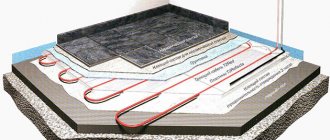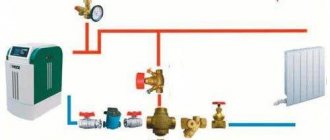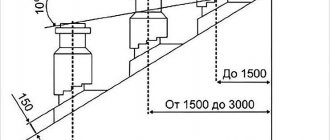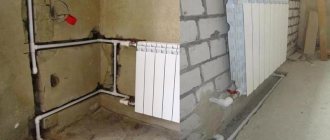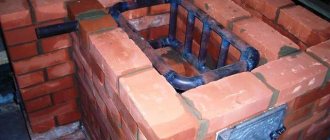Coolant "Warm House" is an inexpensive, non-hazardous and high-quality composition intended for heating systems. In addition, it is not only able to protect the equipment used, but also a safe, environmentally friendly product. It contains protective components that increase its ability to resist scale formation, there is almost no foam formation and the composition is able to slow down corrosion.
Pros and cons of the product
It has the following properties:
- The operating temperature difference ranges from -30 to +106 degrees;
- The working life of the fluid is about 5 years;
- Safe for flax , paronite, rubber, plastic and metal-plastic, eliminating possible leaks;
- Safe substance for humans and animals;
- If the coolant is used only for heating , then its service life increases to 10 years;
- Explosion- and fireproof liquid.
Among the shortcomings it is worth mentioning the following:
- Inability to use electrolysis colas when heating a room;
- The presence of salt in the composition increases corrosion;
- It is necessary to use a composition designed for one of the operating temperatures. The use of a coolant with unsuitable temperature characteristics increases the possibility of glycol deposits forming, which threatens the failure of heating elements and the appearance of resinous deposits;
- Dilution of the “Warm House” composition with other liquids without testing may cause decomposition of additives and reduce the ability of the composition to resist corrosion.
Characteristics and types of coolant
The following brands of coolant are produced:
- “Warm House ECO-20” is an antifreeze made from propylene glycol. Ideal for dual-circuit heating devices;
- “Warm House -30” is an antifreeze made from ethylene glycol, used for heating with single-circuit boilers, but it is also suitable for other designs. When filling systems of double-circuit and tensile boilers, dilution is required;
- “Warm House ECO-30” is made from propylene glycol. When filling systems of double-circuit and tensile boilers, dilution is required;
- “Warm House -65” is a high-concentration composition made from ethylene glycol.
Completely prepared formulations are already diluted to the required concentration.
“Warm House -65” - high concentration composition, produced from ethylene glycol
Application of compositions
The coolant of this brand is a liquid and is more fluid than water. For this reason, it is necessary to install the heating efficiently, after which the system must be pressure tested. Do not forget that it is prohibited to pour this liquid into electrolysis boilers.
Before use, most “Warm House” compositions are diluted with technical or distilled water. After dilution by 10%, its crystallization temperature increases to -25 degrees; if you dilute it to 20%, the characteristics of the solution will change to -20 degrees. After some time of operation, the coolant will begin to become jelly-like. If you dilute it with water at this time, the solution will restore its characteristics.
It is necessary to install the heating efficiently, after which the system must be pressure tested
Recipe for mixing 100 liters of coolant
“Warm Home” is often sold as a concentrate, which must be diluted before use. The proportions of the components affect the characteristics of the final solution (freezing point). If you add 23 liters of water to 77 liters of concentrate, the freezing point of the resulting solution will be about -40 degrees.
By dissolving 35 liters of water in 65 liters of concentrate, you will get a solution that can freeze only at -30 degrees. Adding 40 liters of water to 60 liters of concentrate will give you a mixture that will freeze at 25 degrees below zero. If the frost in your region is no more than 20 degrees, then you need to dilute 54 liters of concentrate with 46 liters of water.
In the equipment, all joints are treated with sealing compounds that are well resistant to the effects of glycol mixtures, or flax is used for this purpose. After the end of its service life, the solution still freezes only at low temperatures, but its anti-corrosion properties are significantly deteriorated.
For this reason, after the end of its useful life, the coolant must be drained and disposed of. Before filling the system with a new solution, be sure to check all components for leaks and completely flush the heating system.
After the end of its service life, the solution still freezes only at low temperatures, but its anti-corrosion properties are significantly deteriorated
Nuances of using antifreeze
For most people, antifreeze is thought of as a liquid that is poured into the car so that it works properly in cold weather. But a similar substance can also be used in private homes. As in cars, you need to choose a certain type of antifreeze, because depending on the amount and type of additives, its properties may vary.
Antifreeze helps protect metal parts from corrosion, dissolves and removes sediment that occurs in the system, and also prevents the destruction of elements made of other materials - silicone gaskets, hermetic layers, rubber seals. In addition, if we compare the heating time of antifreeze and water, the first coolant heats up faster. And this leads to the fact that due to long cooling, the boiler will turn on less often. And this is savings. By objectively assessing such properties of the liquid, it is easy to understand how rational its use in the heating system is. It is against this background that many people replace water with antifreeze.
Such advantages should force owners of private houses to only use antifreeze. But in fact, there are a number of peculiarities that boiler manufacturers put forward for such a liquid. All instructions contain a warning about the categorical prohibition of pouring antifreeze into wall-mounted boiler models. Accordingly, persons who violate such a warning will be responsible for the proper operation of the system themselves. The main mistake of many buyers is that they neglect the manufacturer’s recommendations. That is, if the operating instructions indicate that only water is needed in the boiler, then this is what you need to do. Otherwise, literally after 3-6 months, you will need to call a specialist. And this is not to mention the fact that in finished houses, developers create a heating system, focusing on the physical properties of water.
If a house is just being built or a heating system is just being selected for installation for some reason, then you need to carefully study the technical data sheet of the product. Typically, such documents contain a list of acceptable coolants. The fact is that antifreeze has a heat capacity 15-20% lower than that of water, and its volumetric expansion is 45-60% greater. In addition, it is worth saying that the viscosity of such a substance is 2-3 times greater than that of water. All this can negatively affect the operation of the heating system.
Why is it so important to know about the disadvantages of antifreeze? The fact is that the quality of heating and the service life of the system depend on this. For example, ethylene glycol fluids are very susceptible to high temperatures, since such exposure causes antifreeze to decompose. Anti-corrosion additives are also involved in this process, which is why various types of acids and solid deposits arise. Such substances, as they circulate in the system, lead to the destruction of all elements, and not only metal ones. And this is fraught with the fact that the heating will soon fail. This is especially true for those systems where the internal surfaces are zinc coated. Such precipitation also affects the heating element, since, settling on it, they prevent it from fully releasing heat.
There is one more point worth mentioning - the fluidity of antifreeze. When the system is turned off, as it cools, the metal elements begin to expand. This leads to the coolant finding its way out at the joints of the parts. That is why experts recommend that during the installation of such a system, try to create a minimum of surges. In addition, you need to understand that if the need for repairs does arise, then the pipes must be easily accessible.
Manufacturers say that antifreeze can be used, the main thing is to control it so that the system does not overheat. But they are interested in selling their goods. Judging objectively, it is extremely difficult to carry out such control around the clock. Therefore, before settling on such a liquid, you should think twice, and also prepare money to completely convert the system for anti-freeze heating.
Reviews
Plumber1979, Moscow We use “Warm House” -65 in our heating. It is often counterfeited, but if you buy it from a trusted store, you can hope that it will serve well. Convinced by my own experience.
Sarychev, Obninsk I pour this coolant into the heating myself. But my heating system is low temperature. The temperature is no more than 60 degrees (if it’s 20 outside). It works fine, for heating with temperatures up to 80 degrees, the additives will probably decompose. You must carefully read the certificates to determine the highest operating temperature it can be used. Please also note that heating elements are designed to work with water.
Egor, Kizil I purchased the “Warm House” composition - as soon as I filled the system with the pump, I immediately noticed that the gaskets were leaking. If you use water instead of coolant, then after it you need to tighten all the connections; it is a very fluid liquid. There are no complaints during operation; in winter, this mixture heated the house normally. When we left it for almost three weeks, it did not freeze.
Artem, Syktyvkar Installed an imported heating system and foreign pipes and fittings. But there was no longer enough money to buy 200 liters of imported coolant, so I used “Warm House”. The boiler works great with it, there are no system leaks.
Evgeniy, Pevek If you remember that new antifreeze needs to be added every 5-6 years, my decision to use this mixture will not surprise anyone - it is not very expensive and does not spoil the heating system. True, there is a slight doubt whether its freezing temperature will be enough for the northern regions.
Ideal coolant - myths and disappointments
Let's start with the fact that the ideal coolant for heating a private house does not exist in nature, just as nothing ideal exists. One will be expensive, the other will be ineffective, and the third will quickly corrode all the gaskets, while the fourth will break a couple of sections of the home pipeline when it freezes. And in country houses, which are often used for temporary residence, pipe ruptures are becoming quite common.
A good heating fluid must have the following qualities:
Corrosive safety – the liquid poured into the system should not lead to the formation of corrosion. Many coolants are truly safe for almost all components, both metal and plastic, only they have other disadvantages
The same water can be relatively safe or aggressive, corroding iron or not having any effect on it; Fluidity over a wide temperature range is a very important property for heating systems in country houses. A good coolant should remain liquid at any temperature
Water is no longer suitable here - it freezes at 0 degrees and even causes pipes to rupture, as it tends to expand when cooled. Ethylene glycol becomes more viscous at subzero temperatures, which cannot be said about propylene glycol; Affordable price - you must agree, this is an important factor, but it is very vague. For example, water can be free or very expensive. By collecting it from a well, we will get the simplest coolant almost free of charge, but distilled water in the right quantities will hit our pockets. But we will tell you how to normalize water for its use as a coolant in heating systems of country houses; Minimum amount of salts - the less salts, the less deposits on the walls of pipes and radiators. For example, distilled water is famous for its lack of salt content, while ordinary water may contain a huge amount of salt compounds invisible to the naked eye. During the heating process, chemical reactions occur in the coolant, as a result of which some of the salts become insoluble, precipitating in the form of a terrible growth; Minimal toxicity is a very important property, since some coolants are very toxic. Not only is it dangerous to take them internally, but their vapors and even contact with the skin are dangerous. A typical example of this is inexpensive ethylene glycol, which is poisonous to humans. An alternative is propylene glycol, but it is more expensive; Temperature resistance - a good coolant for the heating system of a country house should remain itself at any temperature. For example, water should remain water and not turn into alkali or some other aggressive substance. But if nothing happens to the water, then organic compounds, which include glycerin, ethylene glycol and propylene glycol, can decompose when heated.
The most important parameter of the coolant is its cost. Water from the tap, from the nearest river or well is almost free or extremely cheap, while distilled water will cost you money.
There is no ideal coolant for heating. See for yourself - water at 0 degrees freezes and expands, threatening to rupture the heating system. Ethylene glycol will eliminate this effect, but it is poisonous. Propylene glycol is not toxic, it is harmless, but expensive. Glycerin does not seem to be very expensive, but it has a destructive effect on rubber gaskets. In other words, there is some kind of “but” everywhere. It seems like water gets under the ideal coolant, but because of it, the heating system of a country house can become overgrown with salt deposits.
Salt build-up in the heating system can be washed off, but this is expensive or ineffective, because sometimes the layer is so thick that it is useless to fight it.
Blitz tips
If you dilute the coolant with water from a well or well, which contains a lot of minerals, then it is advisable to dilute the mixture in a transparent container in order to notice the formation of sediment in time. Considering that in some regions the water is of very low quality, it is advisable in this case to use completely ready-made formulations.
Not recommended:
- Fill galvanized systems because sediment may form from the coolant as a result of a chemical reaction;
- Use the composition in heating with electrolysis boilers;
- Mixing “Warm House” with similar products may cause a decrease in performance properties and service life;
- Overheat the coolant.
The compositions “Warm House -30” and “Warm House -65” are produced only for technical purposes (it contains poisonous ethylene glycol). To prevent poisoning, this composition should not be allowed to get into drinking water or food. If it gets on the skin, the area must be washed well with soapy water.
"Warm House-ECO" is suitable as a refrigerant in food production. But this does not mean at all that, for example, you can drink it. All types of coolant are explosion-proof and do not support combustion.
If necessary, the coolant must be stored in an airtight container, inaccessible and protected from sunlight; they should not be placed near food products.
What are the advantages and disadvantages of water coolant?
Water can rightfully be called the cheapest and most accessible coolant. Moreover, almost all modern heating boilers, shut-off valves, pipelines and other structural elements are designed specifically for water circulation. Plus, if an emergency occurs and the coolant leaks outside, it will be ordinary water, which will not harm human health in any way. But in addition to its advantages, such a universal coolant has a number of equally significant disadvantages:
- In the event of a sudden onset of frost and the heating system is not started, this can lead to rupture of the pipeline, and in some cases, the central boiler. But regardless of the extent of the damage, repairing them will require a lot of money and time.
- If water is used as the main coolant for a long period, then scale will form on the inner walls of all heating units, which leads to excessive consumption of energy resources by up to 30%. This, in turn, leads to additional costs for heating the home.
If we consider home heating assembled using metal pipes, then during prolonged contact of water and metal, especially if the batteries are not completely filled with coolant and there is air in them, corrosion will occur and, as a result, breakdown of the heating system.


